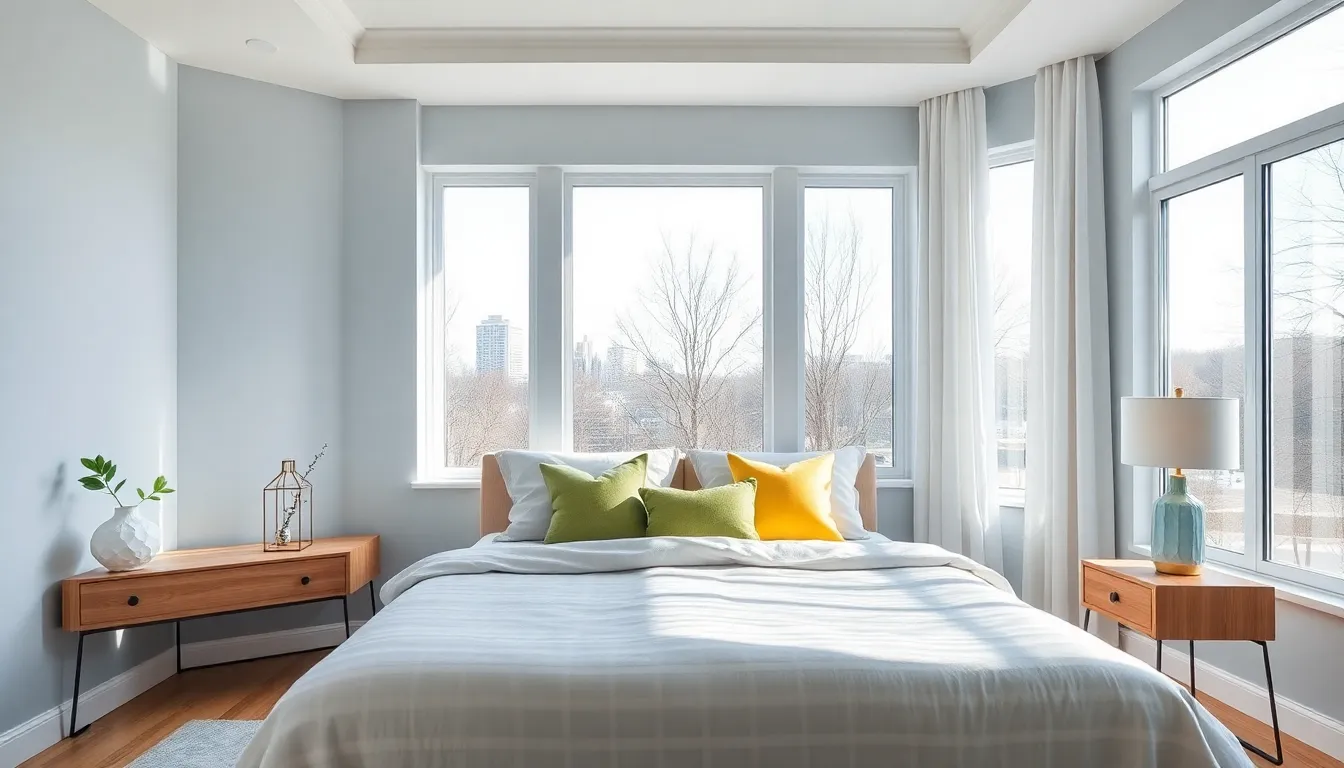Choosing the right color scheme for a bedroom can transform the space into a personal sanctuary. Colors have a profound impact on mood and atmosphere, making it essential to select hues that resonate with individual preferences and lifestyle. Whether someone craves a serene retreat or a vibrant haven, the right palette can make all the difference.
From calming neutrals to bold accents, the options are endless. Each color evokes unique feelings, influencing relaxation and energy levels. Understanding the psychology behind colors helps in creating a harmonious environment that reflects personality and promotes well-being. This article explores various color schemes that cater to different tastes, ensuring every bedroom becomes a true reflection of its inhabitant.
Table of Contents
ToggleUnderstanding Color Schemes for Bedrooms
Color schemes play a crucial role in bedroom design, influencing both aesthetics and emotional well-being. Selecting the right colors creates an environment that resonates with personal style and enhances the overall atmosphere.
Importance of Color in Design
Color choices directly affect how a space feels. Harmonious color schemes can create balance and cohesion, while contrasting colors introduce energy and excitement. For bedrooms, calming tones often prevail, promoting relaxation and comfort. Incorporating complementary shades fosters a visually appealing environment, guiding the eye naturally from one area to another. Color schemes reflect personal taste, making the space feel unique and tailored.
Psychological Effects of Color
Colors evoke emotions and can significantly influence mental states.
- Blue: Associated with tranquility, blue tones can create a serene atmosphere, ideal for relaxation and restful sleep.
- Green: Representing nature, green encourages calmness and rejuvenation, making it perfect for a restful sanctuary.
- Yellow: This cheerful hue stimulates creativity and energy but can overwhelm when overused. A soft, muted yellow strikes a balance.
- Red: Known for being energizing, red can increase heart rates and stimulate conversation, making it less suitable for restful spaces.
- Purple: Often linked with luxury, purple tones can inspire creativity and a sense of calm, beneficial for peaceful sleep.
Understanding these psychological effects aids in selecting appropriate colors, ensuring the bedroom feels inviting and reflective of individual preferences.
Popular Color Schemes for Bedrooms

Bedrooms often reflect personal style through color choices. Several popular color schemes can create desired moods while enhancing aesthetics.
Neutral Color Palettes
Neutral color palettes offer versatility and timelessness. Shades like beige, gray, and white create a serene backdrop, promoting relaxation and comfort.
- Beige functions as a warm base, pairing well with accent colors or textures.
- Gray provides a modern feel, making it easy to adapt for various design styles.
- White contributes to an airy ambiance, helping small spaces appear larger.
Combining different neutral hues can add depth without overwhelming the senses, ensuring a peaceful retreat.
Bold and Vibrant Colors
Bold and vibrant colors create striking bedroom aesthetics and energize the space.
- Red injects passion and excitement, perfect for stimulating energy levels.
- Yellow brightens the environment and promotes creativity, ideal for artistic personalities.
- Turquoise adds a fresh vibe, reminiscent of water, promoting calmness and clarity.
Using bold tones as accents against a neutral base can balance vibrancy with sophistication, ensuring a dynamic yet cohesive look.
Creating Cohesion with Color
Creating cohesion with color enhances the overall atmosphere of a bedroom. A well-thought-out color palette fosters harmony and balance, crucial for relaxation and personal expression.
Choosing Complementary Colors
Choosing complementary colors involves selecting hues that are opposite each other on the color wheel. This approach creates visual interest and can highlight different elements within the space. For example:
- Blue and Orange: Blue promotes tranquility, while orange adds warmth and excitement. Together, they establish a balanced environment.
- Red and Green: Red energizes the space, while green introduces calmness. Their combination can create a vibrant yet peaceful retreat.
- Purple and Yellow: Purple inspires luxury, while yellow stimulates creativity. Using them together enhances both sophistication and energy.
Incorporating these complementary colors can lead to a visually stimulating bedroom that feels cohesive and purposeful.
Balancing Warm and Cool Tones
Balancing warm and cool tones ensures a well-rounded and inviting space. Warm tones, like reds, oranges, and yellows, evoke energy and coziness, while cool tones, such as blues, greens, and purples, promote tranquility and relaxation. To achieve this balance:
- Use Warm Accents: Incorporate warm colors in accents like throw pillows and artwork to create inviting focal points.
- Apply Cool Backgrounds: Use cooler colors for larger areas, such as walls, to foster a calming backdrop.
- Mix Textures: Add variety with different textures in both warm and cool hues to enhance depth and interest.
Strategically balancing warm and cool tones unifies the color scheme and creates an atmosphere conducive to rest and rejuvenation.
Tips for Selecting the Right Color Scheme
Selecting the right color scheme enhances a bedroom’s ambiance and reflects personal style. Thoughtful consideration of various factors leads to an ideal choice.
Considering Room Size and Lighting
A room’s size impacts color perception and overall feel. Small rooms benefit from light colors, which create an illusion of space. Pale shades like soft whites, light grays, and pastels make areas appear larger and more open. In contrast, larger rooms can accommodate darker hues, providing warmth and intimacy.
Lighting also plays a crucial role. Natural light can brighten up colors and shift their undertones throughout the day. North-facing rooms, which receive less sunlight, may need warmer tones to add vibrancy, while south-facing rooms can utilize cooler colors to maintain balance. Testing paint samples under different lighting conditions ensures an accurate display of colors.
Personal Preferences and Style
Individual style heavily influences color choices. One’s personality dictates preferred shades, whether opting for calming blues and greens or energetic reds and yellows. Identifying one’s desired mood aids in selecting appropriate colors.
Combining colors that resonate personally while aligning with current trends creates a harmonious look. Utilizing color swatches can help visualize possibilities. Additionally, drawing inspiration from favorite artwork or textiles can guide color selections, leading to a cohesive and personalized space.
Choosing the right color scheme for a bedroom is a vital step in creating a space that feels both personal and inviting. By understanding the emotional impacts of different colors and how they interact with light and space, individuals can craft an environment that reflects their unique style and enhances their well-being. Whether opting for calming neutrals or bold accents, the key lies in achieving balance and harmony. Thoughtful color choices can transform a bedroom into a sanctuary that promotes relaxation and rejuvenation. Ultimately, the right palette not only elevates aesthetics but also fosters a sense of peace and comfort, making it a true reflection of one’s personality.




